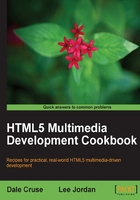
Specifying the pubdate of an article
"The
pubdateattribute is a boolean attribute. If specified it indicates that the date and time given by the element is the publication date and time of the nearest ancestor<article>element, or, if the element has no ancestor<article>element, of the document as a whole." - WHATWG's HTML5 Draft Standard - http://whatwg.org/html5
Getting ready
The new pubdate is an attribute for the new <time> element when it exists within the new <article> element. It allows us to be even more precise when presenting the date and time of publication.
How to do it...
In this recipe we'll build on the new <time> element from the last recipe and add the new optional pubdate attribute to display our publication date.
<!DOCTYPE html> <html lang="en"> <head> <meta charset="UTF-8"> <title></title> <!--[if lt IE 9]><script src=http://html5shiv.googlecode.com/svn/trunk/html5.js> </script>[endif]--> <meta name="viewport" content="width=device-width, initial-scale=1.0"> </head> <body> <article> <header> <h2>Headline</h2> <p>Published on <time datetime="2010-11-29" pubdate> November 29, 2010</time> in the something category.</p> </header> <p>First paragraph</p> <p>Second paragraph</p> <footer></footer> </article> <article> <header> <h2>Headline</h2> <p>Published on <time datetime="2010-11-28" pubdate> November 28, 2010</time> in the something category.</p> </header> <p>First paragraph</p> <p>Second paragraph</p> <footer></footer> </article> </body> </html>
How it works...
Pubdate is simply a binary variable, or Boolean, attribute to denote when something was published.
There's more...
You can think of pubdate as adding extra information to an element (<time>) that is already providing extra information. It is like the cherry on a sundae. And who doesn't like cherries on their sundaes?
Still waiting on browsers
We are getting really forward-thinking by including new elements like <mark>, <time>, and pubdate, as none are fully supported by any browser — yet.

Modern browsers like Firefox display the new <time> element and pubdate attribute natively without styling.
Extra credit
You can code the new pubdate Boolean attribute as <time datetime="2010-11-29" pubdate="pubdate"> if you want to conform to XML syntax.
Let's end confusion
Even though HTML5 is still quite new, there's already some confusion about the new pubdate Boolean attribute. Some think it should generate the date of publication based on your computer clock or a server. That's not its role. Its role is to produce a machine-readable publication date that is useful no matter what text you may put after it.
See also
Tantek Celik has created a very useful site at http://favelets.com that features all sorts of "bookmarklets" or in-browser JavaScript commands. Use these to do things like validate HTML5, CSS, and anchors all in the same window. Very helpful!